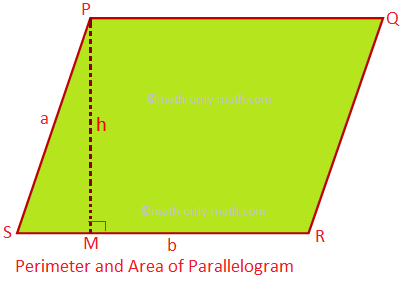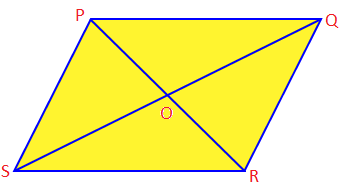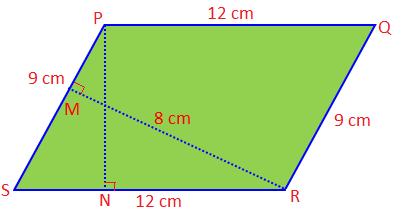Subscribe to our ▶️ YouTube channel 🔴 for the latest videos, updates, and tips.
Perimeter and Area of Parallelogram
Here we will discuss about the perimeter and area of a parallelogram and some of its geometrical properties.
Perimeter of a parallelogram (P) = 2 (sum of the adjacent sides)
= 2 × a + b
Area of a parallelogram (A) = base × height
= b × h
Some Geometrical Properties of a Parallelogram:
In the parallelogram PQRS,
PQ ∥ SR, PS ∥ QR
PQ = SR, PS = QR
OP = OR, OS = OQ
Area of the ∆PSR = area of the ∆QSR = area of the ∆PSQ = area of the ∆PQR = \(\frac{1}{2}\) (area of the parallelogram PQRS.
Area of the ∆POQ = area of the ∆QOR = area of the ∆ROS = area of the ∆POS = \(\frac{1}{4}\) (area of the parallelogram PQRS.
Solved Example Problem on Perimeter and Area of Parallelogram:
1. Two sides of a parallelogram are 12 cm and 9 cm. If the distance between its shorter sides be 8 cm, find the area of the parallelogram. Also find the distance between the longer sides.
Solution:
Area of the parallelogram PQRS = base × height
= PS × RM
= RS × PN.
Therefore, area of the parallelogram = 9 × 8 cm\(^{2}\) = 12 cm × PN
Therefore, 72 cm\(^{2}\) = 12 cm × PN
or, PN = \(\frac{72}{12}\) cm = 6 cm
Hence, the distance (PN) between the longer sides = 6 cm.
From Perimeter and Area of Parallelogram to HOME PAGE
Didn't find what you were looking for? Or want to know more information about Math Only Math. Use this Google Search to find what you need.





New! Comments
Have your say about what you just read! Leave me a comment in the box below. Ask a Question or Answer a Question.